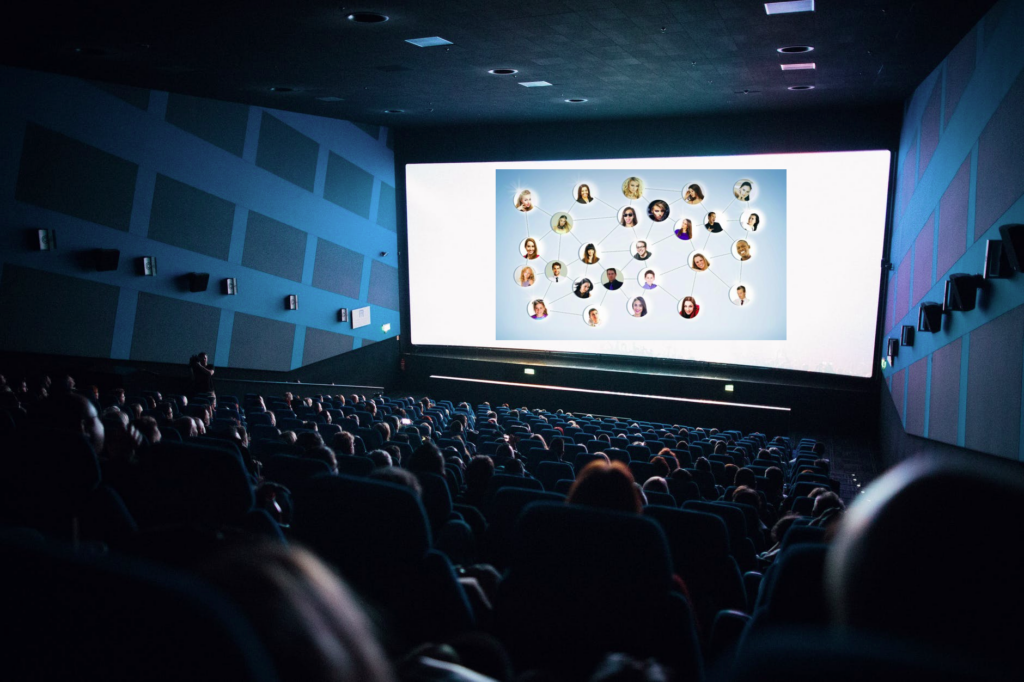Bringing the “Big Screen” Down to Size
All you need to see is how movies are available on streaming apps and at movie theaters simultaneously to know that a lot has changed in the way fans get their movie fix. Who could have ever imagined it even just a few years ago, let alone the 90 years since Police Patrol became the first movie shown on TV?
Movie theaters have taken a huge hit because of the pandemic and are still slow on their way to recovering, with ticket sales down nearly 70% since before the pandemic and only rebounding at a snail’s pace.
Such stats are disheartening for those of us who still enjoy the brick-and-mortar silver screen experience, but it’s the way the intertwined consumption of movies and the evolution of media are heading. Pandora’s — or rather, the pandemic’s — box has been opened and there’s no going back now.
Although it’s true that movie theater attendance came back and then exploded after the 1918 pandemic hit it hard, folks had zero at-home movie viewing options. These days, the supply of such options appears to be limitless, which changes things significantly.
While the pandemic was a beatdown coming out of nowhere for movie theaters, as it has been for the whole world, no doubt some changes in the evolution of media and movie viewership are going to be permanent. Regardless of how much life becomes normalized, the changes worldwide have just been too deep.
As Aparna Acharekar, the programming head at ZEE5 India, pointed out in Vogue earlier this year,
“We recorded that more and more people adopted OTT [web-based streaming] as their source of entertainment. Homes that didn’t have WiFi also got a broadband connection. People upgraded their mobile internet. The time allowed us to adopt and access technology. The entire value chain got affected in a very positive way.”
Navigating Downstream to a Growing Sea of Audience Choices

Streaming apps have provided many more choices for ways to experience movie entertainment than the Big Six Studios could probably even dream of. With less than half of the usual movies made by the big Hollywood studios in 2020 compared to 2019, the pandemic has been keeping the number of films made by big studios down.
At the same time, multiple streaming services such as Netflix and Disney Plus are each making dozens of movies this year, and getting close to — if not matching — the number of movies put out by Hollywood. Not only are movies made by these services winning Oscars, but also Oscar-winning movies sections have become a staple of the services’ offerings. You can even watch the best medieval series online, sitting in the comfort of your home.
Stats tracking the way fans experience movies show how the evolution of video streaming has seriously impacted viewers’ tastes, too. A survey by HighSpeedInternet.com this year shows that a whopping 75% of 1,000 respondents would rather watch a new release at home than attend movie premieres in theaters.
Not Just About You, But Y’all, Too

It’s rare for most moviegoers to interact with other people in the theater. However, turning movies into social events has increased substantially in popularity.
In watch parties on social media platforms such as Facebook and streaming apps such as Netflix and Hulu, fans can host and watch movies together while chatting. Facebook Messenger even lets participants chat through live video during a movie.
These gatherings can happen at participants’ own convenience — when it suits them and how it suits them. Basically, it’s all about a custom viewing experience, with the focus moving away from theaters towards viewers themselves.
As the number of platforms with a social media streaming component continues to grow and develop new features, many consider the rise of the watch party to be a mainstay and not just a pandemic-induced one-off. Such sources base their predictions on online-specific benefits to fans such as promotions, live commentary, and conversations with individual moviemakers — as well as a growing realization of and excitement about what’s possible through social streaming experiences in general.
While streaming apps have created greater individual choice and recognized that watching movies can be a communal act, the greatest player in American entertainment has been lagging in some important areas.
Those Letting Movie History Leave Them Behind

While some players in movie production have evolved to meet the needs and interests of fans, it seems that some players haven’t evolved at all, especially Hollywood.
Although movies have been adapted to audiences through new technologies such as streaming apps, the established American movie industry’s Big Six Studios haven’t quite gotten the memo because their neglect can disappoint audiences they purport to please.
For every movie breaking the bank, four more don’t break even. Beyond the relatively anemic practice of test screenings, the same industry often doesn’t seem interested in knowing what movie fans actually want — as long as it can justify making too many underwhelming movies, crossing its fingers, and hoping for a few blockbusters.
Ultimately, this makes the common notion that fans “vote with their wallets at the box office” into more of a myth than a fact.
Film.io: Forging a New Epoch of Film History in Blockchain
With Film.io, fans and creators have all the advantages of streaming apps but many more, as Film.io goes even farther than they do to rival (but not replace) the Hollywood mainstream.
These advantages include new levels of convenience and choice, more opportunities to contribute to and benefit from their favorite movie projects, and more community possibilities, culminating in an experience that not only mirrors trends but also combines them and takes them to exciting new places.
As far as convenience goes, everything at Film.io is done on its online platform — not only for end users, whom streaming apps also aim to please and sometimes do, but also for creators and investors. As for movie choices, fans not only choose which movies to watch, they choose which ones get made.
How do fans do it? Through their evaluation of projects. Along with the votes of Film.io’s movie token hodlers (many of whom will be fans themselves), fans directly determine project greenlighting decisions through the platform’s innovative, convenient and investment risk-abating ‘Go Score’.
Furthermore, fans are encouraged to get involved in many other ways that neither Hollywood nor streaming apps provide, including advocating, influencing, viewing, curating, donating to favorite projects, reviewing, and subscribing, as well as evaluating. Also, fans can play a more participatory, even more fundamental role by staking Film.io’s native FAN and FILM movie tokens and earning more of them on its blockchain movie crowdsourcing platform.
Concerning community fan involvement, Film.io is like social movie streaming on steroids. Not only can fans communicate with each other directly about movies they support, but they can also interact directly with creators as well.
Blockchain is the ideal technology for Film.io’s new crowdfunding movie platform, too, since DeFi blockchain technology is amenable to community and transparency, and its consensus-driven validation requires it.
With Film.io, fans, creators, and even investors create a truly vested community of movie lovers. Together, all stakeholders in Film.io strive to meet what contemporary audiences want and usher them into new theaters of value.
Author Bio
Stephanie Smith, Project Manager at Filmio. Film.io’s crowdfunding movie platform provides a stellar spot for fan-creator interaction, no doubt reinforced by a more extraordinary shared experience and even economic connection as it pioneers blockchain financing of film for everyone.















